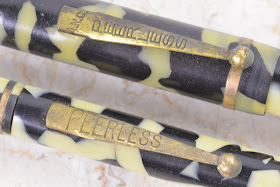This article has been edited and included in The Leadhead's Pencil Blog Volume 5; copies are available print on demand through Amazon here, and I offer an ebook version in pdf format at the Legendary Lead Company here.
If you don't want the book but you enjoy this article, please consider supporting the Blog project here.
I always thought “Peerless” was a funny name to apply to a product ... it doesn’t actually say the product is better than any competing product, only that there is nothing on exactly that level. Without peer might mean nothing else is that good, or in the alternative that nothing out there is that bad.
In the case of the hapless Peerless pens and pencils, I think it’s largely the latter. Nevertheless, I do have a couple things to show you from the brand. The first is this time capsule:
Talk about a gold mine of information – too bad it isn’t about something collectors care about a little bit more! We have a date of October 6, 1948, and a clear indication that the Paulmay Company was the distributors for the Peerless Fountain Pen and Pencil Company. Inside, there’s some detailed paperwork and a pen and pencil set in a leather case:
I thought about omitting pictures of the pen and pencil out of the case, since they are bad. I mean, really bad . . .
Still, the caps themselves have a bit of style, even if they don’t fit so well on the writing instruments so well:
The paperwork that comes with it is pretty funny – note that the guarantee is that the set is “worth more than its special radio price of only $1.95.”
It also provides a physical address for Peerless: 14 West 17th Street, New York:
The instructions contain nothing pencil related, but here there are in the interests of completeness:
The Peerless brand was another one which appears to have either been handed off several times or appropriated by several people over the years. Here’s a set that I picked up at an antique show years ago:
Although the pen and pencil share the same plastic, the clips are a little different – still, I think this is probably a matched set:
The sloped “Peerless” on the pencil clip is a little different; then there’s the “A.N.C.” aove the name on the pen, which stands for American News Corporation (see
https://leadheadpencils.blogspot.com/2013/02/so-what-does-anc-mean.html).
However, these don’t bear any indication that the American News Corporation was involved at all:
They both simply have the word “Peerless” on the back side of the barrel:
However, the plastics, those bolted-on clips and those flared caps all scream Eagle - contemporary with the Riteaway and Magnum Pointer series:



















































